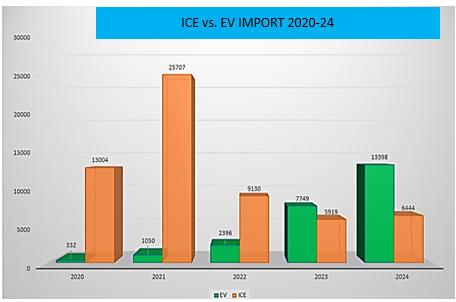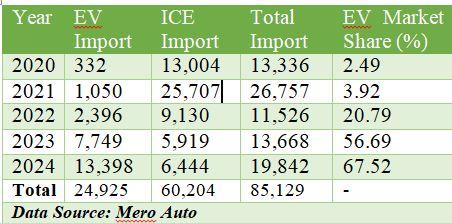A dramatic change has been observed over the last five years, especially in Nepal’s automotive industry, especially in the four -wheeler section. Import of electric vehicles (EV) has increased rapidly, while the import of the combustion engine (ICE) has decreased.
Mero Auto data, as shown in the table below, indicates that the EV market share has increased rapidly, in 2020 only 2.49% impressive 67.52% up to 67.52% in 2024. This change raises important questions about that readiness. Such land. Rapid change and further challenges.
The Historical Perspective and Gradual Adaptation of New Technologies
Nepal has had a century-long history with automobiles, starting from the early days when vehicles were physically carried by hundreds of laborers due to a lack of infrastructure. In earlier times, vehicles from European, Russian, and Japanese manufacturers were present on Nepal’s roads.
As a result, the ideas of road design and infrastructure can be affected by these vehicles. The Nepalese Automobile has also witnesses the successful running of Electric buses known as trolly Bus for a long period as city bus serving the best mode of local transportation joining two cities in Kathmandu and Bhaktapur.
Over time, Indian cars have dominated the Nepali market, and utilized the right hand compatibility, proximity, simple availability of spare parts and linguistic and cultural equality. This century-luminated appearance has contributed to a well-established infrastructure for service after sale, the availability of parts and operating efficiency. Adaptation of new techniques, especially in ice motors, is historically developing in response to global technological progress and the country’s unique geographical challenges.
Structured table import in numbers

Rapid vs. Gradual Transition: Which Path is Nepal Taking?
For any country that does not manufacture or invent automotive technology, the adaptation process is a strategic choice. There are two approaches to technological adaptation:
- Rapid Transition: A swift move to new technology, which can sometimes be disruptive if not backed by necessary infrastructure and policies.
- Gradual Transition: A steady transformation that allows existing industries and support systems to evolve in tandem with technological advancements.
Nepal seems to be on a rapid path, as indicated by the sudden surge in EV imports. But are we prepared for this transition? The questions still remain to be answered.
Are We Ready for the Change?
The sudden shift to EVs and the latest technology is not solely the country’s choice. Whatever the reason, it presents both opportunities and challenges for the automobile industry in Nepal.
The primary reason for the rapid shift in user adoption could be the taxation difference—ICE vehicles are taxed around 260%, whereas EVs are taxed around 100-125%. This tax factor is a governmental action, possibly with good intentions, prior preparation, or a random decision to support the Paris Agreement and Nepal’s goal of achieving carbon neutrality by 2045. If so, we should acknowledge the government’s preparedness in supporting EVs and welcome the transition as normal.
However, regardless of the circumstances, several factors need to be addressed to ensure the sustainability of this shift:
- Infrastructure Readiness: The availability of charging stations, service centers, and trained personnel remains a key challenge.
- Government Policies and Accountability: Which institutions are responsible for overseeing this transition? The government, regulatory bodies, and automobile associations must work together to facilitate a smooth shift.
- Experience of Distributors: Are all Nepalese automobile distributors equipped to handle the transition from ICE vehicles to EVs? Their knowledge, experience, and service capabilities will be critical.
- Financial Capability of Distributors: As vehicles are imported from China, India, or other countries and sold to dealers or customers, the efficiency of distributors plays a vital role. This business is not suited for startups alone.
Stop promoting Startup: This might not be the good business for the startup, collaborating with experienced organization should be encouraged. Government policy may always Encourages new agencies and new comers which is also important, but customer protection must be prioritized to avoid ability service gaps. While startups convey innovation, their long-time period viability and dedication to after-income service are uncertain. Policies should examine monetary capability and ensure responsibility.
Manufacturers’ Capability: Any manufacturers produce and sell automobiles no doubt, but the manufacturer’s capability on spare elements handling, quality handling and safety handling capability need to be observed by the regulatory body of Nepal in the High-degree of precautions. Like authentication of producers must be strictly monitored and it should not be only limited in the papers for formalities.
The Road Ahead
While Nepal’s shift to EVs is commendable from an environmental and monetary point of view, the transition should be sponsored with the aid of robust guidelines, advanced infrastructure, and technical expertise. The authorities and stakeholders need to ensure that this shift does not result in a situation where consumers are left with automobiles that cannot be maintained because of a lack of aid services.
Quality product assurance must be ensured by the authorities.
“Another concern is whether all EV four-wheelers are suitable for hilly terrains or if a more judgmental approach is needed. Are all distributors adequately qualified to handle technological issues? Is setting a minimum fund availability criterion for problem management truly a good option? There are several factors to be concerned about.”
Differences between EVs and Traditional ICE Vehicles
High-tech, computerized EVs with autonomous features may seem sophisticated compared to rigid ICE vehicles. EVs offer a light, vibration-free driving experience with the all latest safety features.
In a country such as Nepal, where vehicle registration books still include asking the information about the car has a radio or not?, whether the transport department can handle the complexities of the GPS satellite-controlled vehicles?
This emphasizes the government’s readiness or disability, which directly affects real distributors, quality producers and reliable products.
Nepalese government departments do not seem ready to assess these technologies effectively.
The discussion on EV adoption in Nepal is not just about numbers but about readiness and sustainability. A well-planned strategy, incorporating both policy support and infrastructure development, will determine whether this transformation becomes a success story or a future challenge.
Conclusion
Every day that action is delayed, the risks grow. We must start today—identify the problems, implement necessary changes, and ensure that rushed decisions do not result in wasted time and wealth. Proper planning is crucial, including:
- Effective waste management for EV batteries
- Adequate manpower and technician training
- Strategic policies ensuring sustainable EV adoption
- Value for Money: If implemented properly, EV adoption will prove to be a valuable asset to users. It will reduce fuel imports, utilize domestic electricity, support the country’s GDP, and save national funds. Otherwise, all efforts will be in vain.
Welcoming EVs and new technology is not the issue—the real challenge lies in creating a well-structured plan for long-term success.
The author, Anil Kumar Baral Shree (PhD Scholar), is the Central Vice President of Nepal Automobile Association and has more than 20 years of experience in the automobile industry.







Comments are closed.